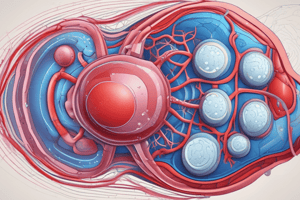Podcast
Questions and Answers
What is a primary distinction between colloids and crystalloids in fluid therapy?
What is a primary distinction between colloids and crystalloids in fluid therapy?
- Crystalloids are used exclusively for the treatment of dehydration.
- Crystalloids are only used in emergency situations.
- Colloids contain larger molecules than crystalloids. (correct)
- Colloids provide more electrolytes than crystalloids.
What role does RAAS play in fluid and electrolyte balance?
What role does RAAS play in fluid and electrolyte balance?
- RAAS is involved in the metabolism of lipids and fats.
- RAAS acts as a fluid and electrolyte equalizer by influencing blood pressure and volume. (correct)
- RAAS only affects sodium levels in the body.
- RAAS primarily regulates the absorption of glucose in the kidneys.
In clinical practice, which type of fluid is often utilized to expand intravascular volume?
In clinical practice, which type of fluid is often utilized to expand intravascular volume?
- Colloids are rarely used for volume expansion.
- Electrolytic solutions are considered the best option for volume expansion.
- Only hypertonic solutions are effective for volume expansion.
- Crystalloids are typically preferred for expanding intravascular volume. (correct)
Which statement correctly describes the use of electrolytes in fluid therapy?
Which statement correctly describes the use of electrolytes in fluid therapy?
What is a common misconception regarding fluid types in treatment?
What is a common misconception regarding fluid types in treatment?
Study Notes
RAAS as a Fluid and Electrolyte Equalizer
- Renin-angiotensin-aldosterone system (RAAS) plays a crucial role in regulating fluid and electrolyte balance
- Activated when blood pressure drops or sodium levels are low
- RAAS system constricts blood vessels, leading to increased blood pressure
- RAAS also increases sodium reabsorption by kidneys, increasing water retention
- Aldosterone, a hormone produced by RAAS, promotes potassium excretion, rebalances electrolytes
Types of Fluids (According to Composition)
- Fluids can be categorized based on their composition
- Crystalloids are solutions containing electrolytes and water, they easily cross cell membranes
- Colloids are solutions containing larger molecules (like proteins) that stay in the bloodstream
Colloids vs Crystalloids
- Crystalloids are typically used for fluid resuscitation, replacing lost fluids and electrolytes
- Colloids are used to expand plasma volume and increase blood pressure
- Choosing between colloids and crystalloids involves assessing the specific needs and condition of the patient
Studying That Suits You
Use AI to generate personalized quizzes and flashcards to suit your learning preferences.
Related Documents
Description
Explore the role of the renin-angiotensin-aldosterone system (RAAS) in fluid and electrolyte regulation. This quiz covers key concepts like fluid types, their compositions, and the differences between crystalloids and colloids. Test your understanding of how these elements interact to maintain homeostasis.




